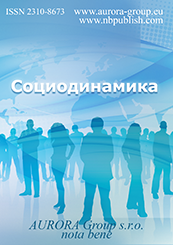Social studies and monitoring
Reference:
Trinadtsatko, A.A. (2021). Performing art as an instrument of increasing social activity of the visually impaired people . Sociodynamics, 4, 1–21. https://doi.org/10.25136/2409-7144.2021.4.35415
Abstract:
The object of this research is the process of sociocultural rehabilitation of the people with disabilities as an instrument for their social adaptation and integration. The subject of this research is performing art ad form of manifestation of social activity of the visually impaired people. The goal consists in compiling social portrait of a typical participant of inclusive theater for visually impaired people and establishing correlation between the theatrical activity of such people and their social activity in other spheres of life. Leaning on the analysis of scientific sources and own empirical research, the author attempts to compile an exemplary portrait of the visually impaired person participating in the inclusive theater for such invariant of persons with heath limitations. The author also drawn parallel between the social characteristics of the visually impaired people, their participation in theatrical activity and social activity in other spheres of life. The novelty of this work consists in compiling social portrait of the typical representative of inclusive theater for visually impaired people, which indicates that men with severe visual impairment in the age group 41-15, who have higher education, are employed, attend cultural and sports events, have skills of artistic reflection of the surrounding world and creative potential, are more involved in such activities. Their theatrical activity is not so much an instrument of sociocultural rehabilitation, but rather a means of personal fulfillment and self-actualization through public participation in stage performances and receiving public recognition. The scientific value of the acquired results lies in the fact that based on formation of social portrait of an actor with visual impairment in the inclusive theater, the author proposes the vectors for conducting multidisciplinary studies of various invariants of the discredited stigma group of persons with health limitations in the context of reflection of their social characteristics and for improving the instrumental, artistic, and efficient components of art therapy.
Keywords:
inclusive theater, social integration, social activity, social adaptation, animation technology, sociocultural rehabilitation, disabled people with visual impairments, stage art, artistic result, art of the disabled
The heritage of transformation
Reference:
Sevostyanova, E. (2021). Mobilization in everyday life of the population of Trans-Baikal Region during the period of “Chinese complications” (1900-1901) . Sociodynamics, 4, 22–47. https://doi.org/10.25136/2409-7144.2021.4.32551
Abstract:
The object of this research is the everyday life of Trans-Baikal Region during the military-political conflict. The official name of the conflict was “Military Campaign in China 1900-1901”, but in common practice it was called “Chinese complications” and “danger on the borders”. The subject of this research is mobilization in everyday life of the population of Trans-Baikal Region during the period of “Chinese complications” (1900-1901). The author examines the impact of mobilization upon life of the population, which behavioral strategies and psychological reactions were prevalent, assessments of the population regarding the causes of the conflict and its consequences for Trans-Baikal region, what and what language was used to describe it. In the analysis of newspaper materials, the article employed the methods of determining semantic-lexical elements; considered the methodological ideas of studying everyday life as a correlation between power strategies and tactics of everyday life. It was established that the population identified mobilization with uncontrolled natural disasters and catastrophic events, such as crop setback, floods, and large-scale epizootics. Mobilization alongside the Russia-China conflict overall, did not entail a surge of anti-Chinese sentiments, although incited xenophobia. The author explores the main issues of everyday life determined by mobilization and measures taken by the regional authorities aimed at ensuring security of the border areas and preventing famine. Analysis is conducted on the ideological and informational role of the church. The Trans-Baikal Church led the charity work, and all priests were authorized to accept donations.
Keywords:
Russian-Chinese relations, Chinese prisoners of war, ethnic stereotype, Trans-Baikal region, military everyday life, rebellion in China, mobilization, The Russian-Chinese conflict, Zabaykalsky Church, military and political conflict
Questions of current interest
Reference:
Vecherina, O. (2021). Institutional limitations and possible vectors of the development of mediation in Russia . Sociodynamics, 4, 48–67. https://doi.org/10.25136/2409-7144.2021.4.35492
Abstract:
The object of this research is the socio-legal institution of mediation as an alternative dispute settlement procedure in Russia. The subject of this research is the peculiarities of development of this institution and their substantiation by the specificity of institutional implementation, as well as cultural-historical aspects of the Russian society. The author indicates that the longstanding efforts of enthusiasts with the support of government structures aimed at the development of mediation as a legal institution outside its social component (mediation as an assisting profession) appeared to be ineffective and even faced rejection of a considerable part of society, as its conceptual grounds on the foundation of law do not correspond with the cultural-historical matrix of Russia. Special attention is given to the peculiarities of the establishment of mediation as a social institution and assisting profession. The author concludes on the presence of basic institutional restrictions of the development of socio-legal institution of mediation in Russia, due to the absence of mediation mechanisms of development (according to A. S. Akhiezer). The novelty of this work consist in tracing the dynamics of institutional development of mediation in the context of social evolution of the Russian society. The author believes that successful development of mediation in Russia as a social institution and assisting profession is not only possible, but essential; first and foremost, school mediation combined with remedial practices, as an effective technique of helping families, including families with children, and as instruments for working with ethno-confessional conflicts.
Keywords:
dynamic, mediation mechanisms, institutional restrictions, institutional implementation, institute, alternative dispute resolution, mediation, development, helping professions, restorative justice
Political elites
Reference:
Rakhinsky, D.V., Illarionov, G.A., Piskorskaya, S.Y., Rusakov, A.G., Shcheblyakov, E.S. (2021). Alienation of tradition as a way of person's relationship with the past. Sociodynamics, 4, 68–81. https://doi.org/10.25136/2409-7144.2021.4.35546
Abstract:
The subject of this research is the alienation of tradition as a way of relating to the past. The goal of this article consists in conceptualization of an “alienated tradition” as a mode of relationship between the social present and the social past, generated by the historical dynamics of development of the tradition, which is simultaneously a factor of social development and a source of personal suffering. The research methodology leans on the principle of social epistemology, which implies following the mutual conditionality of evolution of representations on connection between the present and the past, reflected in the concept of tradition sociocultural mechanisms of the tradition. The article analyzes the language of interpretation of tradition as a combination of sociocultural mechanisms connecting the social present and the past. The novelty of this work consists in interdisciplinary synthesis of the concepts and research positions: the classical concept of alienation, research on intergenerational communication and cultural memory, socio-criticism studies, and theory of suffering. The alienation of tradition suggests objectification of these connections, in terms of which the social past perceived by a person as the new and communicative grounds for the alienation of tradition, emerged as result of increasing vicariousness of intergenerational communication. The alienation of tradition has a dual meaning. On the one hand, it becomes the foundation for self-determination of a person with regards to cultural continuum, force of development, due to the fact that a person is no longer positioned as a result of determinacy by the past, but an active subject who transforms the world relying on own mind, rather than the legacy of the past. On the other hand, the alienation of tradition becomes a cause of suffering; the more vicarious becomes the person’s relationship with the past, the more antagonistic and alienated become the grounds for his existence in culture that are determined by the past.
Keywords:
linguistic alienation, written tradition, non-written tradition, cultural memory, cultural continuum, traditions and innovations, alienation tradition, tradition, communicative alienation, suffering
Social studies and monitoring
Reference:
Sushko, V.A. (2021). The role of personal social capital in shaping the quality of life. Sociodynamics, 4, 82–93. https://doi.org/10.25136/2409-7144.2021.4.32515
Abstract:
The subject of this research is the analysis of the impact of social capital upon the quality of life. The author reveals the theoretical-methodological approaches of foreign and Russian scholars towards the concept of social capital and its components. In the course of research, it was established that personal social capital affects the quality of life of the Russian residents, outlines the circle of their interests and values, as well as provides real opportunities for the fulfillment of personal interests and needs. This article leans on the empirical data that was obtained as a result of a questionnaire-based survey conducted in 2019 and involved 1,803 people from 22 constituent entities of the Russian Federation. The main conclusion of this research consists in the statement that personal social capital, namely such its components as financial security and social connections, affect the quality of life of the people, to a certain extent form the range of their interests and values, as well as provide real opportunities for the fulfillment of personal interests and needs.
Keywords:
value structure, material security of the individual, quality of life, social capital, social activity, socio-economic status, social ties, volunteer work, sociological research methodology, charity
Questions of current interest
Reference:
Medvedeva, N. (2021). The peculiarities of organization and problems of development of the territorial public self-government in the conditions of territorial differentiation . Sociodynamics, 4, 94–101. https://doi.org/10.25136/2409-7144.2021.4.32481
Abstract:
The development of the territorial public self-government (TPS) has been recently prompted by the adoption of national projects that imply additional activation of social resource in the territory. The capabilities of TPS in realization of social service procurement should expand. The article is dedicated to examination of territorial disparities in the development of territorial public self-government in Russia. The subject of this research is the organization of TPS in the conditions of regional differentiation. The branches of the territorial public self-government are unevenly distributed across the country, and their development potential is quite low. The novelty and practical significance of this work lie in the attempt to generalize the practices of implementation of TPS in various Russian regions (the constituent entities of the Russian Federation were allocated in proportion to the number of federal districts), as well as to outline the priority vectors in the development of TPS in the current context. The conducted comparative analysis allows concluding that despite the substantial differentiation in allocation of TPS branches across the country, the difficulties of its development in all indicated regions are similar: insufficient funding of TPS by the local self-governments, low interest in supporting TPS with the legal entity status, low social activity of the population along with the level of information awareness of the citizens on the forms of their participation in self-government. As a result, the capabilities of TPS in implementation of socioeconomic policy of the municipality are limited; the local authorities and TPS are not partners due to mutual distrust and low interest in the development of TPS as a social institution.
Keywords:
social activity, social and economic development, municipal policy, municipal government, territorial differentiation, territorial public self-government, local community, interaction, region, limitations
Questions of current interest
Reference:
Svinukhova, Y.N. (2021). Increase in the employment rate of women with children as a priority vector of social development in the Republic of Bashkortostan . Sociodynamics, 4, 102–118. https://doi.org/10.25136/2409-7144.2021.4.35449
Abstract:
The application of content analysis allowed revealing that the improvement of the status of women in labor relations should become one of the key vectors of social transformation in the Republic of Bashkortostan. First and foremost it pertains to increase in employment rate of women with children of preschool age. The employment of this category of women, as part of human resources, is the crucial problem of the social sphere and social policy. The statistical analysis demonstrated that from the perspective of labor potential, namely this group is most promising due to their size, level of education, active occupational attitudes and values. However, the research indicates that up to 30 % of women in this category face difficulties with employment. In this case, single-parent families, when the main role for financial situation in the family is assigned to a woman, are particularly exposed to risk. The goal of this research is to determine the key barriers in employment of women with children in the regional job market, as well as offer mechanisms for their mitigation. The object of this research is the human resources of the region, while the subject is the employment of women. The theoretical and methodological framework is comprised of the theoretical provisions and methods of the following branches of sociology: sociology of labor, sociology of family, and economic sociology. The empirical base relies on the data from Rosstat and Territorial Federal Service of State Statistics for the Republic of Bashkortostan. In the course of this research, the author employs secondary data analysis and gender approach as a stratification approach. The comparative analysis of statistical data reveals the key trends in the sphere of women’s employment on the regional job market, as well as determines the major barriers in employment of women with children. The article offers mechanisms for alleviating a number of institutional and infrastructural barriers existing in the republic with regards to employment of women.
Keywords:
quality of life, feminization of poverty, income inequality, barriers to employment, women's employment, labor force, gender, statistical discrimination, gender stereotypes, informal employment
Questions of current interest
Reference:
Ravochkin, N.N., Gilyazov, R.S., Shchennikov, V.P. (2021). The impact of COVID-19 pandemic upon changes of temporality and sociality: socio-philosophical analysis . Sociodynamics, 4, 119–135. https://doi.org/10.25136/2409-7144.2021.4.35615
Abstract:
The relevance of the problem of perception of time in the context of permanent changes in modern social life is undeniable. In addition to that, the emergence of such macrosocial factor as COVID-19 has imposed a particular urgency upon the sciences of mind. From the perspective of social philosophy, the authors examine the changes in modern temporality and sociality, which took place under the influence of COVID-19 pandemic. Special attention is turned to the problem of time. The evolution of representations of the perception of time is being followed from antiquity to the present, which constitutes the idea of temporality as such. Another significant aspect is sociality. The specificity and non-triviality of this article predetermined the development of theoretical-methodological foundations of research based on the combination of classical and modern scientific works of the Russian and foreign authors. The novelty of this article consists in the socio-philosophical level of the conducted generalization of precise empirical facts that comprise a holistic picture and adequate understanding of temporality and sociality that have changed under the influence of COVID-19 pandemic. The authors’ special contribution consists in describing the structure of temporality that have transformed in the conditions of the coronavirus pandemic, which incorporates the “palette of temporalities” and includes the postindustrial variant alongside other ways of subjective sense of time up until the the turn of the late Middle Ages – early Renaissance. Applicable to sociality, the authors underline the aggravation of issues in the ordinary social life exposed by the COVID-19 pandemic; under the influence of pandemic, they become not just the risks and threats, but also entail the transformative potential of changes in the traditional practices and remodeling of the entire institutions.
Keywords:
capabilities, crisis, society, transformations, changes, COVID-19, sociality, Temporality, challenges, everyday life
National security
Reference:
Balakleets, N.A. (2021). Spatial aspect of modern warfare: from traditional warfare to cyberwar . Sociodynamics, 4, 136–149. https://doi.org/10.25136/2409-7144.2021.4.32652
Abstract:
This author substantiates the thesis on the importance of spatial factors for conducting warfare. The article traces the evolution of warfare associated with the involvement of new territories and new types of spaces in the orbit of military activity. If the warfare of the past demonstrated a direct dependence on the geographical territory and the related “tensions” (C. von Clausewitz), the modern warfare are emancipated from the geographical shell of the Earth. The article explicates the factors that justify the need for arranging the new warfare spaces. Special attention is given to cyberspace, its structure, and conflicts unfolding therein. The scientific novelty of consists in the interpretation of cyberspace as an expected result of the spatial evolution of warfare. The conclusion is drawn that the emergence of cyberspace contributes to solution of the problem of information vagueness and creation of the stability zones for the military leaders, but at the same is a source of problems not less dangerous for the humanity. The cyberwar winner faces a tempting challenge of establishing global control over the territory of the plane using cyberweapon, or in most pessimistic scenario, its total destruction.
Keywords:
decentralization, information, military activity, cyberattack, cyberspace, cyberwar, space, war, politics, security
 This work is licensed under a Creative Commons Attribution-NonCommercial 4.0 International License.
This work is licensed under a Creative Commons Attribution-NonCommercial 4.0 International License.
 Eng
Eng











 © 1998 – 2025 Nota Bene. Publishing Technologies. NB-Media Ltd.
© 1998 – 2025 Nota Bene. Publishing Technologies. NB-Media Ltd.




